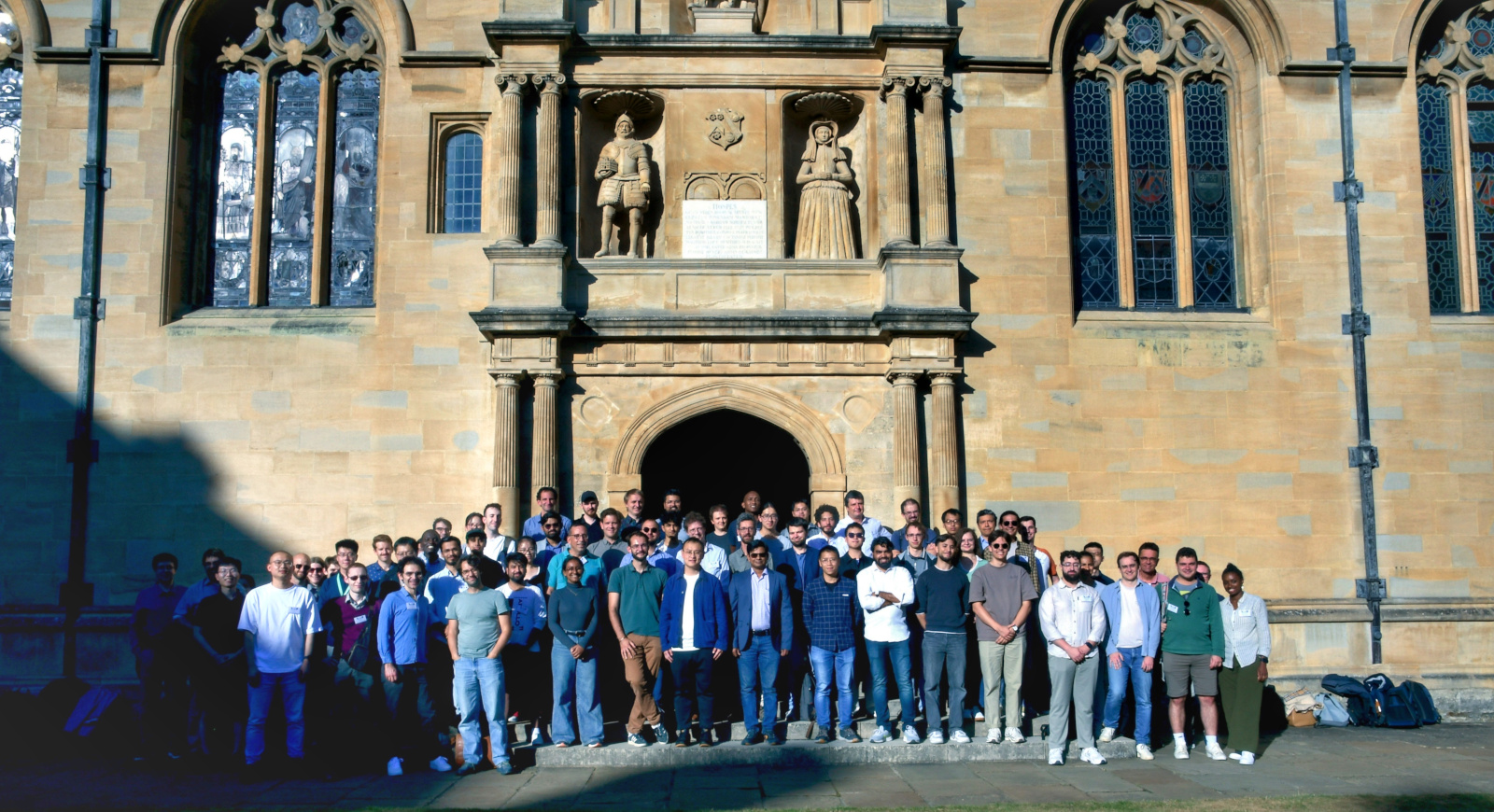Basilisk (Gerris) Users' Meeting 2025
Sponsors

|

|

|

|

|
Summary
The meeting was held on the 7–9th July 2025 at the University of Oxford, United Kingdom, in the Department of Engineering Science.
The format was similar to earlier Basilisk/Gerris meetings held in Paris, France in 2011, Wellington, New Zealand in 2012, Sevilla, Spain in 2014, Princeton, USA in 2017, Paris, France in 2019 and Paris, France in 2023. Participants were encouraged to share their work using Basilisk (or Gerris) for applications in fluid mechanics, environmental science, engineering etc. Students were especially welcome to participate in this informal and friendly gathering.
The meeting was supported in part by funding from the Engineering and Physical Sciences Research Council IAA (Grant number EP/X525777/1).
Program and presentations
Participants
- Wouter Mostert, Department of Engineering Science, University of Oxford, UK.
- Radu Cimpeanu, Mathematics Institute, University of Warwick, UK.
- Stéphane Popinet, ∂’Alembert, Sorbonne & CNRS, Paris, France
- Nausheen Basha, Imperial College London.
- Vatsal Sanjay, Physics of Fluids, Univ. Twente
- Riccardo Caraccio, Politecnico di Milano, IT
- Kaitao Tang, Department of Engineering Science, University of Oxford, UK.
- Nicolo Scapin, Princeton University, US
- Ayush Dixit, Physics of Fluids, Univ. Twente
- Aman Bhargava, Physics of Fluids, Univ. Twente
- Thomas Abadie, University of Birmingham, UK
- Palas Kumar Farsoiya, Department of Chemical Engineering, Indian Institute of Technology (IIT), Roorkee, India.
- Yuanpeng Zhang, Department of Modern Mechanics, University of Science and Technology of China
- Pierre-Antoine Maës, Institute for Combustion Technology, Aachen, Germany
- Jnandeep Talukdar, Physics of Fluids, Univ. Twente
- Mosayeb Shams, Imperial College London, UK
- Debashis Panda, Department of Chemical Engineering, Imperial College London
- Abdullah M. Abdal, Department of Chemical Engineering, Imperial College London
- Tom Sykes, School of Engineering, University of Warwick
- Antoine Aubert, LadHyX, Palaiseau, France
- Canwei Jin, Imperial College London, UK
- Jieyun Pan, Sorbonne & CNRS, Paris, France
- Jie Li, University of Cambridge, UK
- Ziyao Zhang, Department of Engineering Science, University of Oxford, UK.
- Paul-Peter Naanouh, ∂’Alembert, Sorbonne, IFP-Energies Nouvelles, France
- Jean Robin, ∂’Alembert, Sorbonne, ArcelorMittal, France
- Wei Qin ∂’Alembert, Sorbonne, Paris, France
- Tianyang Han, Sorbonne University, Paris, France
- Daniel Fuster, ∂’Alembert, Sorbonne & CNRS, Paris, France
- J.M. Lopez-Herrera, Dept. Ing. Aeroespacial y Mec. de Fluidos, ETSI, U. de Sevilla, Sevilla, España.
- M. A. Herrada, Dept. Ing. Aeroespacial y Mec. de Fluidos, ETSI, U. de Sevilla, Sevilla, España.
- Mina Jafari ∂’Alembert CNRS Sorbonne Université
- Pierre-Yves Lagrée ∂’Alembert CNRS Sorbonne Université
- Antoine Hajczak ∂’Alembert CNRS Sorbonne Université
- Jacob Maarek ∂’Alembert CNRS Sorbonne Université
- Mathilde Tavares ∂’Alembert Sorbonne Université
- Pavan Kumar Kirar, ∂’Alembert CNRS Sorbonne Université, Paris, France
- Theo Witkamp, Fluids & Flows, Eindhoven University of Technology, Netherlands
- Bruno Deremble, Université Grenoble Alpes
- Ilies Haouche, Institut d’Electronique de Microélectronique et de Nanotechnologie, University of Lille, France
- Hiroya Watanabe, Tokyo University of Agriculture and Technology, Japan
- Mustapha Aknine, ∂’Alembert, Sorbonne & CNRS, Paris, France
- Eswara Arun Kishore, Marine Engineering, Indian Maritime University, Kolkata, India
- Lars Willas Dreyer, Department of Mathematics, University of Oslo, Oslo, Norway
- Jiarong Wu, Courant Institute of Mathematical Sciences, New York University
- Øystein Lande, Ocean Oasis AS & Department of Mathematics, University of Oslo, Oslo, Norway
- Victor Boniou, IFP-Energies Nouvelles, Rueil-Malmaison, France
- Marc Cordelle Vacher, LadHyX, CNRS & Ecole Polytechnique, Palaiseau, France
- Alfonso Castrejon-Pita, Department of Engineering Science, University of Oxford, UK.
- Ben Fudge, Department of Engineering Science, University of Oxford, UK.
- Sherry Majidi, The Royal Grammar School High Wycombe, UK.
- Tharul Wanni Arachchige, The Royal Grammar School High Wycombe, UK.
- Divya Shah, The Royal Grammar School High Wycombe, UK.
- Marcus Logothetis, The Royal Grammar School High Wycombe, UK.
- Ishar Toor, The Royal Grammar School High Wycombe, UK.
- Jens Eggers, School of Mathematics, University of Bristol, UK.
- Arnaud Antkowiak ∂’Alembert CNRS/Sorbonne Université
- James Sprittles, Mathematics Institute, University of Warwick, UK.
- Andriarimina Daniel Rakotonirina, The Ocean Cleanup, The Netherlands
- Miguel A. Quetzeri-Santiago, Instituto de Investigaciones en Materiales, UNAM, Mexico
- Fanshuo MA, ∂’Alembert CNRS Sorbonne Université
- Ian Roberts, Aerotex UK
- Sai Raja Gopal Vadlamudi, Institute of Fluid Dynamics, Helmholtz-Zentrum Dresden-Rossendorf, Germany.
- Datong Wang, LadHyX, Ecole Polytechnique, Palaiseau, France
- Yifan Han, Institute of Fluid Dynamics, Helmholtz-Zentrum Dresden-Rossendorf, Germany
- Minerva Schuler, Department of Engineering, University of Warwick, UK.
- Muwanguzi Stephen Kyazze, College of Ocean and Civil Engineering, Shanghai Jiaotong University
- Ahmed Basil KOTTILINGAL, Paris
- Sebastian Dooley, Department of Engineering, University of Warwick, UK.
- Francesco Picella, ∂’Alembert, Sorbonne & CNRS, Paris, France
- Fei He Department of Engineering and Science, University of Oxford, UK
- Peter Lewin-Jones, Mathematics Institute, University of Warwick, UK
- Aston Over, Royal Grammar School High Wycombe, UK
- Anurag Muthyala, The Royal Grammar School High Wycombe, UK
- Edoardo Cipriano, Politecnico di Milano, IT
- Tianning Tang, Department of Mechanical and Aerospace Engineering, University of Manchester
- Xiaosheng Chen, Department of Engineering Science, University of Oxford, UK.
- Zheni Fei, Department of Engineerinng Science, University of Oxford,UK
- Xinyu Liu, Department of Engineering Science, University of Oxford, UK
- Nguyen Quang Chien, University of Edinburgh, Scotland.
- Jiayu Li, School of Engineering and Materials Science, Queen Mary University of London, UK
- Shiqi (Shawn) Qu, The Royal Grammar School High Wycombe, UK
- Om Mahesh Kumar Prajapati, The Royal Grammar School High Wycombe, UK .
- Gena Panaser, University of Birmingham, UK
- Jacob Cook, University of Warwick, UK
- Lyllian Chanerley, University of Warwick, UK
- Nicolas Cailler, D’Alembert, Sorbonne & CNRS, Paris, France
- Eduard Khramchenkov, slb Abingdon Technology Centre, UK
- Isabella Zarpellon Nascimento, Sorbonne, Paris, France
- Duygu Sap, Maths Institute, University of Warwick, UK.

Organisers
- Wouter Mostert, Department of Engineering Science, University of Oxford, UK.
- Radu Cimpeanu, Mathematics Institute, University of Warwick, UK.
- Stéphane Popinet, ∂’Alembert, Sorbonne & CNRS, Paris, France.
